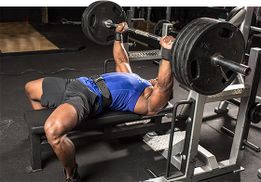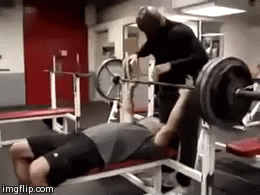Bench Press
The Bench Press is an upper body strength training exercise that consists of pressing a weight upwards from a supine position. The exercise works the pectoralis major as well as supporting chest, arm, and shoulder muscles such as the deltoid muscle, serratus anterior muscle, сoracobrachialis muscle, shoulder, trapezii, and the triceps. A barbell is generally used to hold the weight, but a pair of dumbbells can also be used.[1] The barbell bench press is one of three lifts in the sport of powerlifting alongside the deadlift and squat and is used extensively in weight training, bodybuilding], and other types of training to develop the chest muscles.
Movement
The person performing the exercise lies on their back with a weight grasped in both hands. They push the weight upwards until their arms are extended, not allowing the elbows to lock. They then lower the weight to chest level. This is one repetition.
Powerlifting: take posture with body weight resting on buttocks and upper traps whilst driving feet into the floor. Movement requires the weight to be taken at full arms' length, lowered to upper torso, paused, and then lifted to starting position.
Muscles
A conventional bench press uses pectoralis major muscle, anterior deltoid, coracobrachialis to horizontally adduct the shoulder. It also uses predominantly triceps brachii and anconeous to extend the elbows. Wider hand spacing places a greater emphasis on shoulder flexion and narrower hand spacing utilizes more elbow extension. Because of this, wider hand spacing is associated with training the pectorals and narrower hand spacing is associated with training the triceps.
In addition to the major phasic (dynamic) muscles the bench press also uses tonic (stabilizing) muscles: scapular stabilizers (serratus anterior, middle and inferior trapezius), humeral head stabilizers (rotator cuff muscles), and core (transverse abdominis, obliques, multifidus, erector spinae, quadratus lumborum)
Variations
Variations of the bench press involve different groups of muscles, or involve the same muscles in different ways:
- The flat bench press involves both portions of the pectoralis major muscle but focuses on the lower (sternal) head as well as the anterior deltoid muscle. The term 'bench press' on its own is assumed to refer to a flat bench press.[2]
- An incline elevates the shoulders and lowers the pelvis as if reclining in a chair; this variation emphasizes anterior deltoids with little emphasis at the upper (clavicular) head of the pectoralis major. This variation is called the incline bench press.[3]
- A decline bench press elevates the pelvis and lowers the head, and emphasizes the lower portion of the pectoralis major.
- A reverse grip bench press utilizes an underhand (supinated) grip on the bar. A supinated grip externally rotates the humerus, which puts the shoulders in a much more favorable position for the lift, decreasing injury potential without compromising range of motion. It emphasises the clavicular head of the pectoralis major more than an incline bench press. On the eccentric phase of the lift, the bar path will create a larger arc and eventually touch a point on the chest that is lower compared to the regular bench press, because the upper arms and elbows are closer to the body and the angle between the humerus and the torso is smaller.[4]
- A bench press performed with the hands far apart ("wide grip") shortens the range of motion, lessening the contribution of the triceps.
- A lifter can elect to lower the bar to nipple level, to the xiphoid process, or even further, to the abdomen. On the other hand, a lifter may lower the bar to a very high point on the chest, or even to the neck; the latter variation is called a guillotine press and emphasizes the upper pectorals.
- An 'equipped' bench press is performed with a Bench shirt, supportive shirt that allows greater weights to be used. The materials and cut of the bench shirt, as well as the skill of the lifter and the rules of performance, will determine how much additional weight can be pressed in the shirt as opposed to without it. The contrast between equipped, and unequipped (raw) bench press weights is illustrated in the progression of the bench press world records, with the record equipped lift exceeding the unequipped lift by hundreds of pounds.
- People who suffer from shoulder injuries can use a specialised barbell such as the Swiss Bar or Football Bar that allows them to press with their hands in a position that places less stress on the shoulder. Another variation is the Hex Press in which two dumbbells are squeezed against each other, with the palms facing inwards. This puts the strain of the exercise on the triceps and inner chest rather than the shoulders. The Floor Press is another variation that puts less strain on the lifter's shoulders, due to the shorter range of motion.
Possible injuries
Performing the bench press can contribute to multiple types of injuries:
- Torn ligaments/tendons in shoulders.
- Injuries to the trapezius muscle.
- Elbow/wrist strains.
- Cracked or broken ribs, usually the result of bouncing the bar off of the chest to add momentum to the lift or a loss of strength causing the bar to fall onto the chest.
- Torn or damaged rotator cuff.
- Pectoral muscle tear.
Notes
- ↑ [1] John F. Graham (August 2000). "Dumbbell bench press". Strength and Conditioning Journal. Retrieved 7 September 2014.
- ↑ [2]"Barbell Bench Press Video Exercise Guide & Tips - Muscle & Strength". Muscleandstrength.com. Retrieved 2014-08-14.
- ↑ [3] "Barbell Incline Bench Press". Exrx.net. Retrieved 2014-08-14.
- ↑ [4] Phung, John (2013-08-14). "Master the Reverse-Grip Bench Press". T Nation. Retrieved 2014-08-14.


